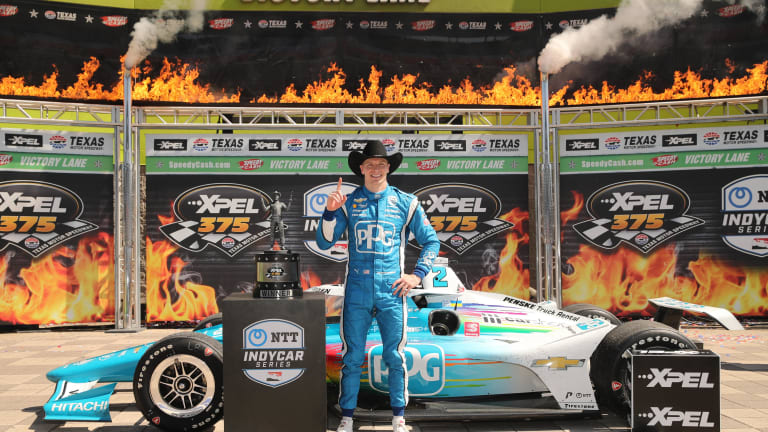
Memo to IndyCar: Don't give up on Texas Motor Speedway

Beware the high line, they said, as in don’t even go there. It’s a one-lane track, and anyone who dares race two-wide through a corner might as well reserve a wrecker to pick up the pieces.
That was the book on racing an IndyCar around Texas Motor Speedway in recent years because, well, it was reality. The PJ1 traction compound applied to the middle groove through the turns of the 1½-mile oval helped heavier stock cars stick to the pavement, but it made the lighter, faster IndyCars behave like driving on snow.
It created single-file racing in the low groove that not only was uninspiring to watch, it also cast considerable doubt whether IndyCar would go back to the speedway once its contract expired this year.
It would be tragic to lose a track that has been not only a fixture but most times a highlight of the IndyCar schedule since 1997. Six years ago, Graham Rahal beat James Hinchcliffe by 0.0080 second to win at Texas.
But that was like another era compared with the most recent example of follow-the-leader and, frankly, I had an uneasy feeling about Sunday’s XPEL 375. There are only four ovals on the 2022 schedule and losing another would be a dagger to the heritage of the sport, not to mention the heart of a traditionalist (re: old guy) like me who loves open-wheel racing on ovals. Heck, I miss seeing dirt on the schedule (Google that, kids).
Going into Sunday’s race, IndyCar took hopeful steps to improve grip in the upper lanes at Texas. They developed aero pieces (barge boards attached low near the sidepods) to create about 200 pounds more downforce and held a special practice on Saturday when cars ran only in the PJ1 to help lay more rubber and (hopefully) add grip to the upper lane.
I had my doubts.
A few years ago at Phoenix, when it was clear that track would produce a single-file race for IndyCar, they dragged racing tires along the surface hoping to create more grip in the outside lane. Didn’t work and the race was a bore. That, along with many other reasons, is why IndyCar hasn’t been back to a track with tremendous open-wheel history since it opened in 1964.
I’d hate to see Texas join Phoenix – and Milwaukee, Pocono, Kentucky, Chicago, Kansas City, Homestead … you get the idea – as ovals with nothing more than an IndyCar past.
That’s what made Sunday’s race at Texas such a joy to watch, from beginning to end. Not everyone hugged the bottom all day, and in the end it created a dramatic victory by Josef Newgarden.
Colton Herta climbed into fifth place in the first five laps from his ninth starting spot, including outside passes of Scott Dixon and Helio Castroneves into Turn 1. Pato O’Ward did the same in Turns 3 and 4 on an early restart to move up two positions.
It offered promise, although no absolute evidence that a second lane was opening up. There were dicey moments when David Malukas skated toward the wall as he tried passing Conor Daly high out of Turn 4, then Rinus Veekay doing the same when he drifted high on lap 53 and took Graham Rahal with him.
And rookie Kyle Kirkwood edged into the high line as he attempted a pass in Turns 3 and 4 after a restart, but the car lost grip and he slammed the SAFER Barrier.
During the middle phase of the race, rookie Devlin Defrancesco became as perilous as the second lane. He wiggled and made contact with Takuma Sato, who was attempting an outside pass on Lap 99. And just after a restart on Lap 129, Defrancesco tried to dive under Rahal and Castroneves entering Turn 3, and they all crashed.
Then, something delightful happened.
Newgarden passed Team Penske teammate Scott McLaughlin on a restart to take the lead, and Veekay took the high line to overtake Marcus Ericsson and Will Power. Behind them, Jimmie Johnson was finding his rhythm in his first IndyCar oval race and making outside passes to jump into the top 10, on his way to a sixth-place finish. The second lane actually was working.
McLaughlin led Newgarden on the last lap, but he also had traffic ahead. As McLaughlin stayed tight to the low line, Newgarden took a chance up high through Turns 3 and 4, and his car stuck.
“I wouldn’t have been able to do what I did in 3 and 4 last year,” Newgarden said. “There’s just no way. I would have hit the wall for sure.”
He beat McLaughlin by 0.0669 second.
I hope that’s how long it’ll take Texas Motor Speedway and IndyCar executives to sign a new deal and continue this relationship.
Sunday’s race provided a nice example of the entertainment IndyCar can produce on an oval – from the sheer edge-of-your-seat anxiety of drivers racing inches apart at 210 mph, to fuel strategy, to a race that wasn’t decided until the final quarter-mile.
It was fun racing because, well, there was racing.
Twelve drivers exchanged the lead 15 times, and overall there were 453 passes. If credit goes to the aero pieces or the Saturday practice that helped give the second lane more grip, doesn’t matter. Just keep doing it.
Now it’s up to IndyCar, its teams and its partners to make sure ovals remain a solid presence on the schedule, not an uncertainty.
Follow Kirby Arnold on Twitter @KirbyArnold.